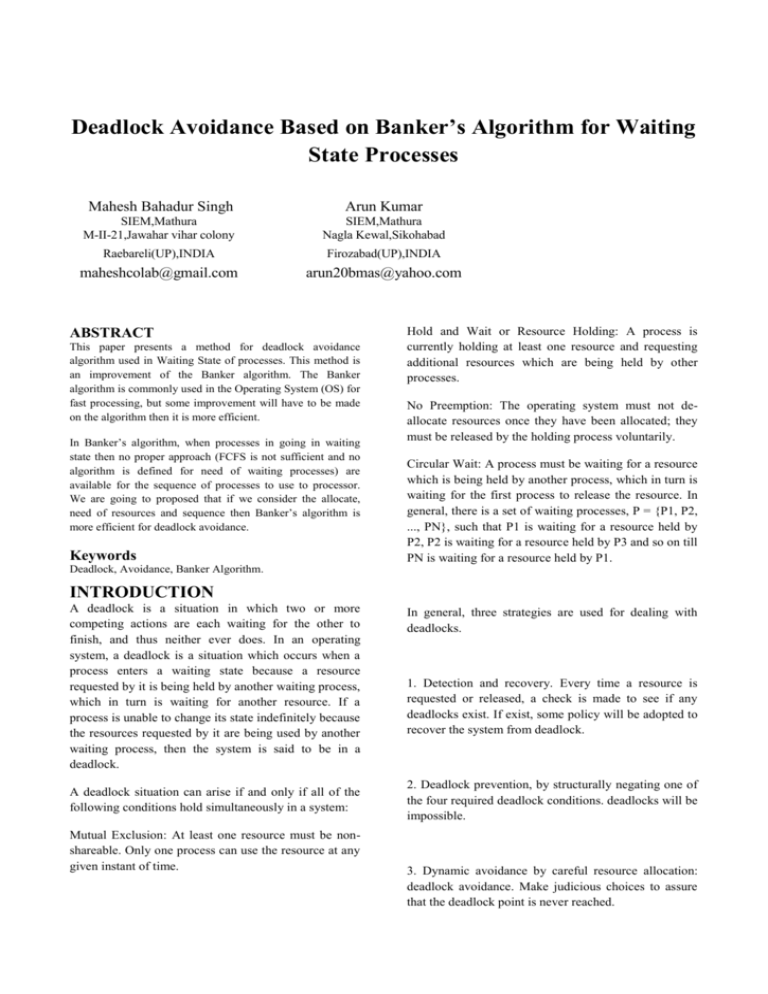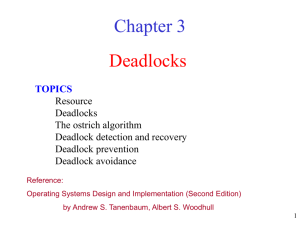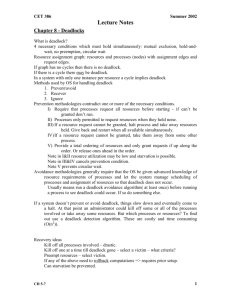f201312211387620919 - Academic Science,International
advertisement

Deadlock Avoidance Based on Banker’s Algorithm for Waiting
State Processes
Mahesh Bahadur Singh
Arun Kumar
SIEM,Mathura
M-II-21,Jawahar vihar colony
SIEM,Mathura
Nagla Kewal,Sikohabad
Raebareli(UP),INDIA
Firozabad(UP),INDIA
maheshcolab@gmail.com
arun20bmas@yahoo.com
ABSTRACT
This paper presents a method for deadlock avoidance
algorithm used in Waiting State of processes. This method is
an improvement of the Banker algorithm. The Banker
algorithm is commonly used in the Operating System (OS) for
fast processing, but some improvement will have to be made
on the algorithm then it is more efficient.
In Banker’s algorithm, when processes in going in waiting
state then no proper approach (FCFS is not sufficient and no
algorithm is defined for need of waiting processes) are
available for the sequence of processes to use to processor.
We are going to proposed that if we consider the allocate,
need of resources and sequence then Banker’s algorithm is
more efficient for deadlock avoidance.
Keywords
Hold and Wait or Resource Holding: A process is
currently holding at least one resource and requesting
additional resources which are being held by other
processes.
No Preemption: The operating system must not deallocate resources once they have been allocated; they
must be released by the holding process voluntarily.
Circular Wait: A process must be waiting for a resource
which is being held by another process, which in turn is
waiting for the first process to release the resource. In
general, there is a set of waiting processes, P = {P1, P2,
..., PN}, such that P1 is waiting for a resource held by
P2, P2 is waiting for a resource held by P3 and so on till
PN is waiting for a resource held by P1.
Deadlock, Avoidance, Banker Algorithm.
INTRODUCTION
A deadlock is a situation in which two or more
competing actions are each waiting for the other to
finish, and thus neither ever does. In an operating
system, a deadlock is a situation which occurs when a
process enters a waiting state because a resource
requested by it is being held by another waiting process,
which in turn is waiting for another resource. If a
process is unable to change its state indefinitely because
the resources requested by it are being used by another
waiting process, then the system is said to be in a
deadlock.
A deadlock situation can arise if and only if all of the
following conditions hold simultaneously in a system:
Mutual Exclusion: At least one resource must be nonshareable. Only one process can use the resource at any
given instant of time.
In general, three strategies are used for dealing with
deadlocks.
1. Detection and recovery. Every time a resource is
requested or released, a check is made to see if any
deadlocks exist. If exist, some policy will be adopted to
recover the system from deadlock.
2. Deadlock prevention, by structurally negating one of
the four required deadlock conditions. deadlocks will be
impossible.
3. Dynamic avoidance by careful resource allocation:
deadlock avoidance. Make judicious choices to assure
that the deadlock point is never reached.
In this paper, we focus on the problem of deadlock
avoidance.
2. BANKER’S ALGORITHM FOR
DEADLOCK AVOIDANCE
The Banker's algorithm is a resource allocation and deadlock
avoidance algorithm developed by Edsger Dijkstra that tests
for safety by simulating the allocation of predetermined
maximum possible amounts of all resources.
For the Banker's algorithm to work, it needs to know three
things:
How much of each resource each process could
possibly request
How much of each resource each process is
currently holding
How much of each resource the system currently
has available
Basic data structures to be maintained to implement the
Banker's Algorithm:
Let n be the number of processes in the system and m be the
number of resource types. Then we need the following data
structures:
Available: A vector of length m indicates the
number of available resources of each type. If
Available[j] = k, there are k instances of resource
type Rj available.
Max: An n×m matrix defines the maximum demand
of each process. If Max[i,j] = k, then Pi may request
at most k instances of resource type Rj.
Allocation: An n×m matrix defines the number of
resources of each type currently allocated to each
process. If Allocation[i,j] = k, then process Pi is
currently allocated k instance of resource type Rj.
Need: An n×m matrix indicates the remaining
resource need of each process. If Need[i,j] = k, then
Pi may need k more instances of resource type Rj to
complete task.
STEP 2: find i such that both
a. Finish[i] is false
b. Need_i <= Work
if no such i, goto STEP 4
STEP 3: Work := Work + Allocation_i
Finish[i] = true
goto STEP 2
STEP 4: if Finish[i] = true for all i, system is in safe state
The resource-request algorithm is used to determine whether
requests can be safely granted. It works as follows:
* Let requesti be the request vector for process Pi. If
requesti[j] = k, then process Pi wants k instances of resources
Rj.
* When a request is made by process Pi, the following actions
are taken:
1. If requesti ≤need go to step 2; otherwise, raise an error
condition.
2. If requesti ≤available, go to step 3, otherwise Pi must wait
since resources are not yet available.
3. Have system pretend to allocate the requested resources to
process Pi by modifying the state as follows:
Available = available - requesti
Allocationi = allocationi+ requesti
If the resulting resource allocation state is safe, then
transaction is complete and Pi is allocated its resources.
If unsafe, Pi must wait and old state is restored.
3. IMPROVEMENT OF BANKER
ALGORITHM
Note: Need = Max - Allocation.
In Banker’s algorithm if some processes are going in waiting
state then no proper approach is available to provide a safe –
sequence.
The safety algorithm is used to determine if a system is in a
safe state. It works as follows:
We are proposed a waiting-state-process algorithm that is
provide a safe-sequence:-it depend upon needi=1,2…n,
Allocationi=1,2…n and Available resources.
It works as follows:
STEP 1: initialize Work := Available;
for i = 1,2,...,n
Finish[i] = false
After the Resource-Request-Algorithm if process going to
waiting state then these step are follows:
Step.1-
Needi is compare to
Need(i+1 to last) .
Step.2-
Take the process with minimum
maximum Allocation.
Need and
Step.3-
If Available<Needi then Execute process. Set state
is excuted.
Step.4Available=Available+Allocationi
Step.5-
Repeat step 1-4 until all
the process is going to
executed state.
4.CONCLUSIONS
In this paper, we proposed that if process is going to waiting
state then how to handle. If we add these Waiting-stateprocess algorithm in Banker’s algorithm then accuracy is
increased. Form the result of the reseach, it can be seen that
the processes is in safe-state. But the algorithm complexity
may be increased.
Acknowledgements:
I should like to acknowledge the
assistance of my books and also a sincere thank to all my
friends and colleague. I am thank full to IJCMS for accepting
my paper. Finally, I thank my parents for supporting me
throughout all my studies
REFERENCES
[1] .
Banaszak, Z.A.; Krogh, B.H.
Deadlock avoidance in flexible manufacturing systems with concurrently competing process flows[J]. IEEE
Transactions on Robotics and Automation, 1990, 6(6), 724 –734.
[2]
I.BenAbdallah ; H.ElMaraghy. Deadlock Prevention and Avoidance in FMS:A Petri Net-Based Approach[J].
International Journal of Advanced Manufacturing Technology, 1998, 16(1).
[3]
Naiqi Wu, MengChu Zhou. Avoiding deadlock and reducing starvation and blocking in automated
manufacturing systems[J]. IEEE Transactions on Robotics and Automation, 2001, 17(5), 658 –669.
[4]
Viswanadham, N.; Narahari, Y.; Johnson, T.L. Deadlock prevention and deadlock avoidance in flexible manufacturing
systems using Petri net models[J]. IEEE Transactions on Robotics and Automation, 1990, 6(6), 713–723.
[5]
T. Araki, Y. Sugiyama, and T. Kasami. Complexity of the deadlock avoidance problem.
In 2nd IBM Symp. Math. Found. Computer Sci., pages 229–257, 1977.





